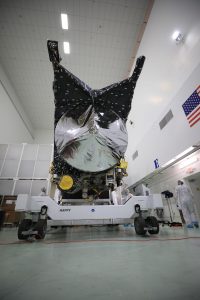NASA’s Psyche mission, which will explore a metal-rich asteroid of the same name, is on track to launch in October 2023 after a one-year delay to complete critical testing. The launch period will open Oct. 5 and close Oct. 25. The asteroid, which lies in the outer portion of the main asteroid belt between Mars and Jupiter, may be the remains of a core of a planetesimal, a building block of a rocky planet.
Due to the new launch date, Psyche has a new mission plan, which includes a flyby of Mars for a gravity assist and arrival at the asteroid in August 2029. The mission then will enter its 26-month science phase, collecting observations and data as the spacecraft orbits the asteroid at different altitudes.
The redesigned flight plan gives the mission more flexibility in how the spacecraft uses its electric propulsion thrusters to reach the asteroid, move between orbits, and remain in orbit.
Unlike many other bodies in our solar system, the asteroid Psyche rotates on its side. Mission planners needed to take this unusual rotation into account as they mapped out the spacecraft’s observation orbits around the asteroid. Another challenge is that the spacecraft will reach Psyche at a different point in the asteroid’s orbit around the Sun than it would have in the previous mission plan. In the original plan, the spacecraft was to sequentially orbit the asteroid at four different altitudes, starting at the highest altitude (referred to as Orbit A) and working its way down to the lowest (Orbit D). In the new mission plan, Psyche will initially enter Orbit A, then descend to Orbit B1, then Orbit D, back out to Orbit C, and finally it will move out to Orbit B2 (the second portion of Orbit B).
This new orbital design ensures that imagers on the spacecraft will have the lighting they need during Orbits B1 and B2. The other orbits are designed to best enable the observations needed by Psyche’s Gamma Ray Neutron Spectrometer, magnetometer, and telecommunications system, which is used for the gravity science experiment.
Engineers and technicians now are completing the final verification and validation of the system-level elements of the fully integrated spacecraft. During this time, tests are performed on the spacecraft as well as in the mission’s three system test beds.
Later this spring, engineers will run a series of “day in the life” tests, when they use test beds to operate Psyche for five to seven days at a time with the same commands that they will use when it is in flight. They will run scenarios in which operations go as planned as well as when operations meet challenges.
The spacecraft is currently in a clean room at Astrotech Space Operations Facility near NASA’s Kennedy Space Center in Florida. In June, the mission begins its final assembly, test, and launch operations, and engineers and technicians from NASA’s Jet Propulsion Laboratory in Southern California will return to Astrotech and work there until launch. Assembly of the spacecraft is complete except for the installation of the solar arrays and the imagers, which may be reinstalled before June. A final suite of tests will be run on the spacecraft, after which it will be fueled and then mated to the launch vehicle just prior to launch. Psyche will launch on a SpaceX Falcon Heavy rocket from Kennedy’s Launch Complex 39A. NASA’s Deep Space Optical Communications technology demonstration, intended to test high-data-rate laser communications, remains integrated into the spacecraft.





